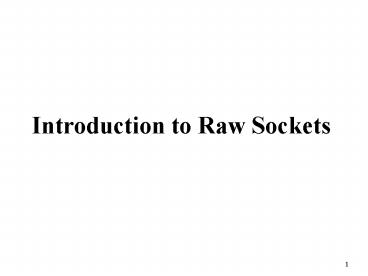Part I: Introduction - PowerPoint PPT Presentation
Title:
Part I: Introduction
Description:
Title: Part I: Introduction Author: Don Towsley Last modified by: Raheem Beyah Created Date: 10/8/1999 7:08:27 PM Document presentation format: On-screen Show (4:3) – PowerPoint PPT presentation
Number of Views:33
Avg rating:3.0/5.0
Title: Part I: Introduction
1
Introduction to Raw Sockets
2
TCP/IP Stack
67 Bootp DHCP
69
53
161
25
23
21
TCPPort
UDPPort
OSPF89
EGP8
Port address
17
6
protocol
2
1
IP address
frametype
MAC address
3
What can raw sockets do?
- Bypass TCP/UDP layers
- Read and write ICMP and IGMP packets
- ping, traceroute, multicast daemon
- Read and write IP datagrams with an IP protocol
field not processed by the kernel - OSPF
- user process versus kernel
- Send and receive your own IP packets with your
own IP header using the IP_HDRINCL socket option - can build and send TCP and UDP packets
- testing, hacking
- only superuser can create raw socket though
- You need to do all protocol processing at
user-level
4
User TCP
User UDP
IGMP
ICMP (ping, etc)
TCP
TCP
UDP
RAW
RAW
port
port
port
ICMP
UDP stack
TCP stack
echotimestamp
port
2
port
89
1
17
6
17 UDP 6 TCP 1 ICMP 2 IGMP 89 OSPF
5
Creating a Raw Socket
int sockfd sockfd socket(AF_INET, SOCK_RAW,
protocol)
IPPROTO_ICMP IPPROTO_IGMP
const int on 1 setsockopt (sockfd,
IPPROTO_IP, IP_HDRINCL, on,
sizeof(on)
- Can we use bind() with raw sockets?
- rare, no concept of port
- Can we use connect() with raw sockets?
- rare, only foreign ip address
6
Raw Socket Output
- Sending raw socket packets by sendto or sendmsg
- If IP_HDRINCL option not set (i.e. header is not
included), the starting address of the data in
sendto() specifies the first byte following the
IP header - If IP_HDRINCL option set, the starting address of
data in sendto() specifies the first byte of the
IP header. - IP Header fields modified on sending by
IP_HDRINCL - IP Checksum Always filled in.
- Source Address Filled in when zero.
- Packet Id Filled in when zero.
- Total Length Always filled in.
- Example see Stevens code under ping/send_v4.c,
ping/send_v6.c
7
Raw Socket Input
- Received TCP/UDP packets are NEVER passed to raw
sockets. If needed, link layer is the place. - Receiving raw packets by recvfrom() or recvmsg()
- Most ICMP packets are passed to all matching ICMP
raw sockets except a few exceptions - ICMP echo request, timestamp request
- All IGMP packets are passed to all matching raw
sockets - All IP datagrams with a protocol field not
processed by the kernel (e.g. OSPF) are passed to
all matching raw sockets - The entire datagram, including the IP header, is
passed to the raw socket. Fragments are
assembled first. - Example stevens code in ping/readloop.c and
ping/proc_v4.c
8
Scatter read and gather writeVectored IO
include ltsys/uio.hgt readv(int fd, const struct
iovec iov, int iovcnt) writev(int fd, const
struct iovec iov, int iovcnt)
struct iovec void iov_base / addr. Of
buffer / size_t iov_len / size of buffer
/
- Send and receive from one or more buffers with a
single function call
9
sendmsg and recvmsg most general of all the IO
functions
recvmsg(int sock, struct msghdr msg, int
flags) sendmsg(int sock, struct msghdr msg, int
flags)
MSG_PEEK MSG_WAITALL
struct msghdr void msg_name / address if
socket is unconnected/ socklen_t msg_namelen
/ size of above / struct iovec msg_iov
int msg_iovlen void msg_control /
ancillary data / socklen_t msg_controllen
int msg_flags / returned status by recvmsg /
scatter gather read/write buffer
MSG_TRUNC MSG_CTRUNC. MSG_EOR (end of
record) MSG_OOB
10
ICMP Format
subtype
11
Ping Program
- Create a raw socket to send/receive ICMP echo
request and echo reply packets - Install SIGALRM handler to process output
- Sending echo request packets every t seconds
- Build ICMP packets (type, code, checksum, id,
seq, sending timestamp as optional data) - Enter an infinite loop processing input
- Use recvmsg() to read from the network
- Parse the message and retrieve the ICMP packet
- Print ICMP packet information, e.g., peer IP
address, round-trip time - Source code Stevens under ping/
12
Traceroute program
- Create a UDP socket and bind source port
- To send probe packets with increasing TTL
- For each TTL value, use timer to send a probe
every three seconds, and send 3 probes in total - Create a raw socket to receive ICMP packets
- If timeout, printing
- If ICMP port unreachable, then terminate
- If ICMP TTL expired, then printing hostname of
the router and round trip time to the router - Source code Stevens traceroute/
13
Limitations
- Loss of Reliability
- No ports
- Non Standard Communications
- No automatic ICMP
- No Raw TCP or UDP
- Must have root (or administrator) privilege
14
When to use
- When you need to control the IP header
- applications like Ping and Traceroute
- not all fields can be set using the IP APIs
- Network Address Translation
- Firewalls
- When your application requires optimum network
speed - one level above the Link Layer
- if you need reliability, you must build it into
your application
15
Windows and Raw Sockets
- WinSock 2.0 allows windows programmers to build
advanced applications - Firewalls
- Network Address Translation
- Packet Filtering
- SYN Flood protection
- Security
- IPSec support
- VPN Clients
- Network Administration
- Packet Sniffers/Analyzers
- Pathway Analyzers (ping and traceroute)































